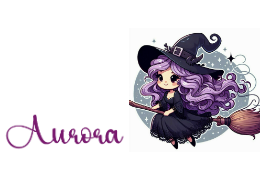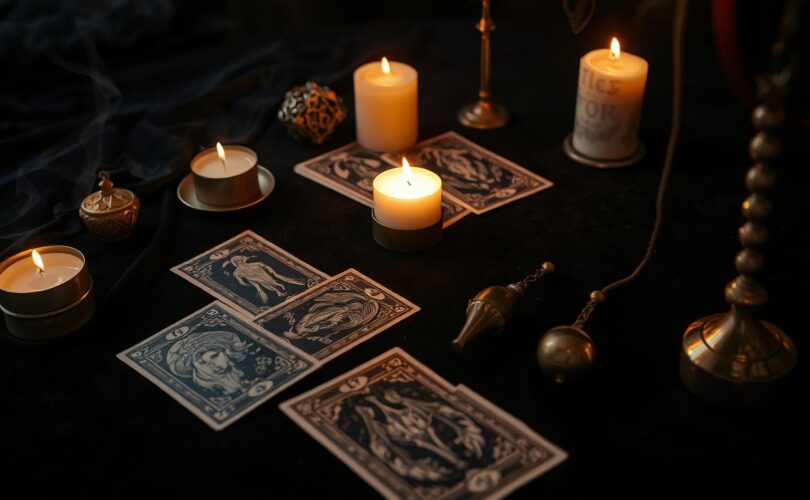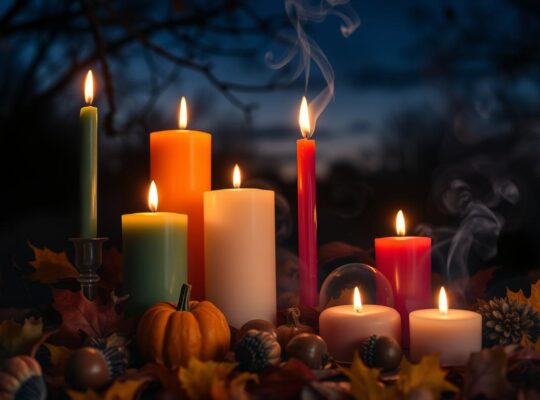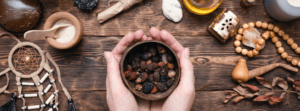When I first held a deck of illustrated cards, I felt a spark of curiosity—like uncovering a forgotten language. My journey began with simple questions: How do symbols speak to us? Can intuition guide decisions? Over time, I realized these tools aren’t mystical shortcuts… they’re mirrors reflecting our inner wisdom.
Centuries-old methods like tarot and crystal-weighted pendulums bridge ancient traditions with modern self-discovery. The tarot’s 78 cards, split into Major and Minor Arcana, weave stories through archetypes. Similarly, pendulums—crafted from quartz or metals—channel energy through deliberate movements. Both rely on a quiet truth: answers often lie within.
I’ve learned preparation matters. Cleansing tools, setting intentions, and grounding yourself create clarity. Resources like Pendulum Magic for Beginners emphasize this ritualistic care. Whether using Barbara Moore’s dual-deck systems or a rose quartz pendulum, the process becomes sacred when paired with patience.
This guide shares what I wish I’d known earlier: how to listen. You’ll explore practical steps, avoid common pitfalls, and discover how to trust that quiet voice beneath the noise. Let’s begin.
Understanding the Basics of Divination
Years ago, a single card pulled during a chaotic week shifted my perspective entirely. The image—a lone figure walking toward mountains—didn’t predict my future. Instead, it mirrored my own resilience. That’s when I grasped what Merriam-Webster defines as “the art of discovering hidden knowledge”—not fortune-telling, but a dialogue with the mind.

What Is This Practice Really About?
Ancient cultures from China to Scandinavia used methods like I Ching and runes to navigate life’s uncertainties. These systems weren’t magic—they were frameworks for reflection. A reading asks us to pause, pose thoughtful questions, and listen inward. One client once tearfully realized her pendulum’s “yes” swings aligned with truths she’d buried for years.
Trusting the Unseen Guide
Your inner voice isn’t loud—it’s a whisper beneath daily noise. I’ve seen a simple tool, like a shuffled deck, reveal patterns clients hadn’t noticed. A message emerges not from the card itself, but how its symbols resonate. That’s the heart of this practice: turning down logic’s volume to hear wisdom that’s always been there.
Tools and Techniques for Beginner Divination
The first time a pendulum swung clockwise in my trembling hand, I understood: tools amplify what we already sense. Let’s explore two foundational methods that transformed my practice—one rooted in imagery, the other in motion.

Exploring Symbolic Mirrors
A tarot deck’s 78 cards—22 Major Arcana and 56 Minor—act as visual prompts for self-reflection. When I lay out a three-card spread, each position (past, present, future) layers the meaning like puzzle pieces. The Tower card might warn of upheaval… or signal liberation, depending on nearby symbols. Your intuition decodes the answer through personal associations.
Listening to Silent Signals
Pendulums translate micro-movements into clear responses. Hold the chain lightly—let it swing freely. Ask yes/no questions aloud. A client once discovered her pendulum circled for “maybe,” revealing hidden doubts. Notice how your hand trembles or steadies. These cues often align with your gut’s whisper.
| Tool | Key Feature | Best For |
|---|---|---|
| Tarot Cards | 78 symbolic images | Complex life questions |
| Pendulum | Physical feedback system | Quick yes/no answers |
| Body Awareness | Natural muscle responses | Trusting inner way |
Both methods thrive on curiosity. Start small—pull one card daily or ask your pendulum about lunch choices. The meaning deepens when you treat it as a dialogue, not a demand.
Divination Practices for Beginners: Tarot, Pendulums, and Intuition
One morning, while sipping tea, I noticed how sunlight danced across my desk—a fleeting moment that later became a metaphor for intuition. Our inner voice speaks through such subtle signals, waiting to be noticed. Like learning a new language, nurturing this connection takes time… but reshapes how we walk our path.
Nurturing Your Inner Guidance
Years ago, a friend described her daily “thumb check”—pressing her thumb and finger together to sense energy shifts. At first, I dismissed it. Yet when I tried it during stressful events, that gentle pressure became an anchor, grounding me in the present.
This practice taught me that guidance often arrives through forms we overlook—a pendulum’s sway, a card’s shadow, or even the way light falls. Regular rituals, like journaling after readings, help patterns emerge over time.
| Practice | Focus | Daily Impact |
|---|---|---|
| Thumb Check | Physical awareness | Grounding in stress |
| Card Reflection | Symbolic patterns | Clarity in chaos |
| Pendulum Pauses | Movement analysis | Decision confidence |
Connecting with Your Higher Self
Imagine your intuition as a friend whispering through the noise of the world. To hear them, try this: sit quietly, place one hand over your heart, and ask, “What do I need to know today?” Notice sensations—a warmth, a twitch, a breath held.
Over time, these moments form a bridge. A client once realized her recurring wrist twitch during readings signaled overlooked opportunities. Now, she pauses to explore that physical cue—a habit that’s transformed her path.
Everyday events become maps when we listen. That delayed train? A chance to breathe. The spilled coffee? A nudge to slow down. The world speaks… if we lean in.
Exploring Alternative Methods of Divination
During a quiet evening in my studio, a client handed me a set of weathered runes—their symbols whispering stories older than words. This moment revealed a truth: countless paths exist to access inner wisdom. Let’s explore two lesser-known methods that have illuminated my practice for.

Oracle Cards, Runes, and Their Meanings
Unlike traditional decks, oracle cards thrive on artistic freedom. The Isis Oracle deck, for example, uses goddess imagery to spark empowerment. Each card becomes a mirror—its meaning shifting with your questions. Runes, carved with ancient alphabets, offer another point of connection. Many people find the Elder Futhark system’s angular shapes help clarify complex decisions.
Tea Leaf Reading and Scrying Techniques
One rainy afternoon, a friend showed me how tea leaves formed a heart shape at her cup’s rim—a part of her grandmother’s practice. Tasseomancy (tea leaf reading) invites us to see metaphors in chaos. Swirl the cup clockwise, then interpret patterns: birds might signal freedom, while chains could mean obligations.
Scrying, using water or mirrors, works similarly. Stare softly until images emerge—a skill that deepens over years. My advice? Start with a dark bowl of water. Let your gaze blur… notice what dances in the shadows.
These methods prove one truth: guidance lives everywhere. Whether through stained porcelain or polished stones, the world speaks in riddles waiting to be solved.
Combining Divination Tools for Enhanced Readings
During a client session last spring, I watched a pendulum swing wildly over the Major Arcana card they’d drawn—The Chariot. Its motion revealed unspoken fears beneath their confident exterior. This moment taught me that layered tools create richer dialogues, like adding spices to a familiar recipe.
Using Pendulums to Supplement Tarot Readings
I often let my pendulum “choose” cards from the deck when a person feels overwhelmed. Hold it above the shuffled pile and ask: “Which card holds the core message?” The subtle dip or swing points to revelations. For complex spreads, I’ll hover it over each position to gauge energy shifts—a technique that clarified a client’s career crossroads last month.
Your body reacts before your mind processes. Notice if your hand trembles when the pendulum passes The Tower or Strength. These physical cues often mirror subconscious blocks needing attention.
Integrating Multiple Methods for Clarity
Start simple: pull one Major Arcana card, then ask your pendulum, “Does this represent an internal or external challenge?” Document the interplay. One student realized her reversed Empress card paired with a “no” swing signaled self-doubt, not failed relationships.
I keep a deck and pendulum board nearby during readings. When symbols feel contradictory, the board’s directional markers (yes/no/maybe) add precision. Last year, this combo helped a team resolve communication gaps before their product launch—proving how blended tools transform abstract guidance into actionable steps.
Remember: integration isn’t about complexity. It’s letting each tool speak its language while you translate the chorus. Trust that synergy. Your inner compass knows how to navigate the noise.
Practical Tips for Developing Your Divination Practice
I once found an old leather-bound journal at a flea market—its pages filled with moon phases and cryptic symbols. That discovery taught me consistency shapes mastery. Growth happens not in grand gestures, but in small, daily acts of attention.
Establishing a Personal Routine
Start with five minutes daily. Pair your practice with an existing habit—morning coffee or bedtime tea. One student uses her “pendulum check-in” while waiting for her toast. Over time, these moments build muscle memory for your inner reader.
Keep tools visible but sacred. A silk-wrapped deck or polished runes on your desk invites curiosity. Document insights in a dedicated journal—even fragmented notes reveal patterns.
Trusting the Whisper Within
Doubt often shouts louder than truth. A client once dismissed a recurring card as “too obvious”—until its meaning unfolded months later. Your first impression usually holds the answer. If your pendulum swings left when expected right, explore why.
Overanalysis numbs intuition. Set a timer: three minutes per reading. Let your body react before your mind debates. That tension in your shoulders? Maybe the material world’s noise clouding clarity.
Evolving Through Practice
Mistakes are mentors. I’ve misread runes, misheard pendulums—each error refined my art. Review old journals monthly. Notice how the Ten of Cups once confused you… now it sings of homecoming.
Barbara Moore’s Book of Shadows Tarot reminds us: “Readings are conversations, not commandments”. Try blending methods weekly. Pair oracle cards with tea leaves. Let your body guide you through the unknown.
| Practice Tip | Benefit | Time Needed |
|---|---|---|
| Daily Card Pull | Sharpens symbolic recognition | 2 minutes |
| Weekly Journal Review | Reveals growth patterns | 10 minutes |
| Monthly Tool Rotation | Prevents creative stagnation | 5 minutes |
Last winter, I watched a sunset paint gold streaks across a frozen lake—a fleeting masterpiece that reminded me how symbols speak through transient beauty. Like those shifting colors, the tools we’ve explored aren’t static answers… they’re invitations to engage with life’s mysteries.
Whether through a pendulum’s swing or a card’s imagery, every symbol acts as a mirror. One client realized her recurring dream of bridges aligned with the Two of Wands’ call to bold choices. These moments reveal what ancient systems knew: wisdom grows when we listen to subtle cues.
Your journey will evolve. Start small—maybe a daily card pull or a pendulum question about weekend plans. Document patterns in a journal. Notice how your body reacts to certain symbols. Over time, these fragments form a map only you can read.
Thank you for walking this path with me. Revisit these pages as your practice deepens. And when doubt whispers, remember: the world speaks in riddles meant to be lived, not solved. A tilted cup, a bird’s flight, the way light falls—each holds guidance waiting to be claimed.
May your journey surprise you. After all, the most profound truths often arrive quietly… like sunlight through winter trees.
Blessed Be!

FAQ
Which divination tool should I start with as a beginner?
I recommend beginning with what calls to you. Tarot decks like Rider-Waite-Smith offer rich symbolism for structured guidance, while pendulums provide quick yes/no answers. If you’re drawn to unstructured exploration, try journaling with your intuition. Trust what feels natural—your curiosity is the best compass.
How does intuition actually work during a reading?
Think of intuition as a quiet conversation… It’s that gut feeling when a card’s image makes your breath catch, or a pendulum swing feels oddly insistent. I’ve learned to notice physical cues—goosebumps, warmth in my chest—as my body’s way of highlighting important messages. With practice, you’ll recognize your unique “language” of inner wisdom.
What’s the difference between tarot and oracle cards?
Traditional tarot follows a 78-card structure with Major and Minor Arcana, offering layered storytelling. Oracle decks vary widely—some focus on angels, others on nature—with freeform interpretations. I use both: tarot for complex life patterns, oracle cards for gentle daily affirmations. Start with one deck to avoid overwhelm.
Can I use a homemade pendulum?
Absolutely! My first pendulum was a necklace held between thumb and finger. What matters is your connection to the object. I’ve seen students use keys, crystals, even a teacup charm. Cleanse it with moonlight or your breath, then program it through intention. The tool simply amplifies what your body already knows.
How often should I practice for reliable results?
Consistency beats marathon sessions. I do 10-minute daily draws, tracking patterns in a moon-phase journal. Pendulum users might ask one focused question each morning. Remember, divination is like muscle memory—the more you honor small insights, the clearer your symbolic vocabulary becomes. Even missteps teach valuable lessons.
What’s the biggest mistake beginners make?
Over-relying on guidebooks instead of their inner voice. I once obsessively checked card meanings, missing obvious themes in my spreads. Now, I let symbols speak first—a cracked cup in the Eight of Cups might mean “release,” not just “emotional loss.” Trust that your perspective adds depth to traditional interpretations.
Can I combine tarot with other methods safely?
Yes—I often pair tarot with pendulum clarifications. For example, pull three cards about a career path, then ask the pendulum: “Does this spread suggest I need more education?” Start simple. I avoid mixing more than two methods until confident. Your energy directs the tools; stay grounded through breathwork between combinations.







